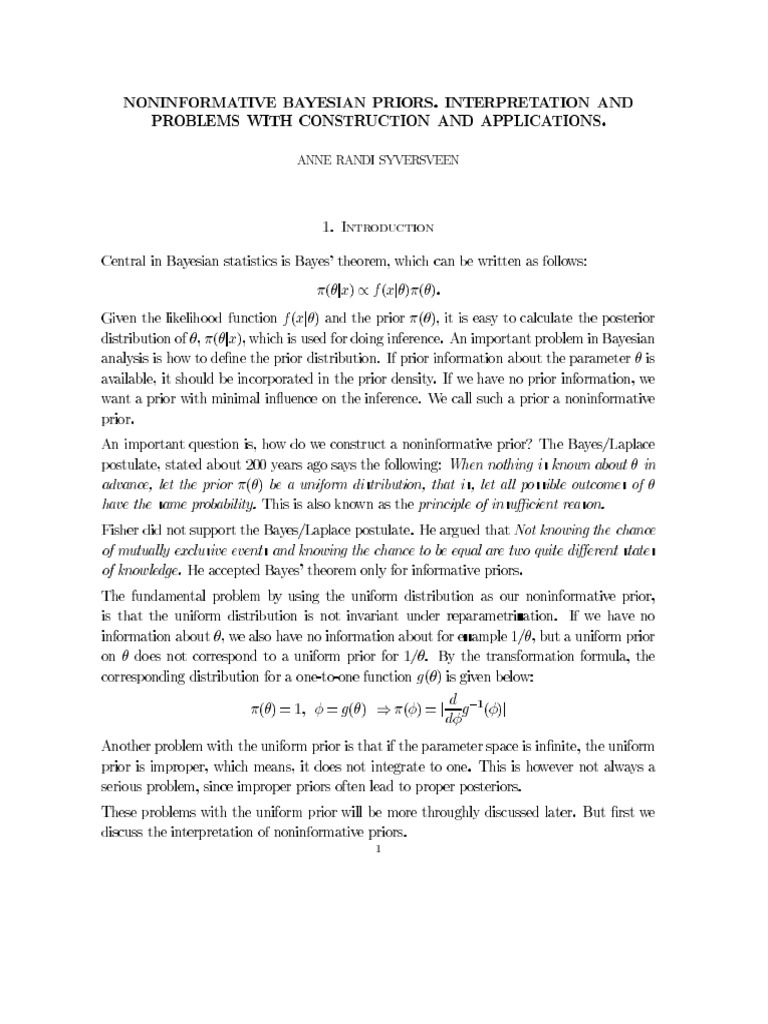Bernardo Smith Bayesian Theory Pdf

This highly acclaimed text, now available in paperback, provides a thorough account of key concepts and theoretical results, with particular emphasis on viewing statistical inference as a special case of decision theory. Information-theoretic concepts play a central role in the development of the theory, which provides, in particular, a detailed discussion of the problem of specification of so-called prior ignorance. The work is written from the authors s committed Bayesian perspective, but an overview of non-Bayesian theories is also provided, and each chapter contains a wide-ranging critical re-examination of controversial issues. The level of mathematics used is such that most material is accessible to readers with knowledge of advanced calculus. In particular, no knowledge of abstract measure theory is assumed, and the emphasis throughout is on statistical concepts rather than rigorous mathematics. The book will be an ideal source for all students and researchers in statistics, mathematics, decision analysis, economic and business studies, and all branches of science and engineering, who wish to further their understanding of Bayesian statistics.
• • • Bayesian probability is an, in which, instead of or of some phenomenon, probability is interpreted as reasonable expectation representing a state of knowledge or as quantification of a personal belief. The Bayesian interpretation of probability can be seen as an extension of that enables reasoning with hypotheses, i.e., the propositions whose is uncertain. Counter Strike Source 1.0.0.72. Programming Software For Icom Ic-f30lt.
Bayesian Statistics. Keywords and phrases: Amount of Information, Decision Theory. Bayesian methods provide a complete paradigm for. The Bayesian paradigm provides a natural way to deal with uncertainty in model selection. (Bernardo & Smith. And has not been used outside of information theory.
Mobilego Android For Mac Download. In the Bayesian view, a probability is assigned to a hypothesis, whereas under, a hypothesis is typically tested without being assigned a probability. Bayesian probability belongs to the category of evidential probabilities; to evaluate the probability of a hypothesis, the Bayesian probabilist specifies some, which is then updated to a in the light of new, relevant (evidence).
The Bayesian interpretation provides a standard set of procedures and formulae to perform this calculation. The term Bayesian derives from the 18th century mathematician and theologian, who provided the first mathematical treatment of a non-trivial problem of. Mathematician pioneered and popularised what is now called Bayesian probability. Broadly speaking, there are two views on Bayesian probability that interpret the probability concept in different ways.
According to the objectivist view, probability is a reasonable expectation that represents the state of knowledge, can be interpreted as an extension of, and its rules can be justified. According to the subjectivist view, probability quantifies a personal belief, and its rules can be justified by requirements of rationality and coherence following from the argument or from the and. Contents • • • • • • • • • • • Bayesian methodology [ ] Bayesian methods are characterized by concepts and procedures as follows: • The use of, or more generally unknown quantities, to model all sources of uncertainty in statistical models including uncertainty resulting from lack of information (see also ). • The need to determine the prior probability distribution taking into account the available (prior) information. • The sequential use of: when more data become available, calculate the posterior distribution using Bayes' formula; subsequently, the posterior distribution becomes the next prior. • While for the frequentist a is a (which must be ), so that the frequentist probability of a hypothesis is either 0 or 1, in Bayesian statistics the probability that can be assigned to a hypothesis can also be in a range from 0 to 1 if the truth value is uncertain.
Bayesian References. (1985), Statistical Decision Theory and Bayesian Analysis (Second Edition. M., and Smith, Adrian F. (1994), Bayesian Theory. Bayesian References. (1985), Statistical Decision Theory and Bayesian Analysis (Second Edition. M., and Smith, Adrian F. (1994), Bayesian Theory.
Objective and subjective Bayesian probabilities [ ] Broadly speaking, there are two interpretations on Bayesian probability. For, interpreting probability as extension of, probability quantifies the reasonable expectation everyone (even a 'robot') sharing the same knowledge should share in accordance with the rules of Bayesian statistics, which can be justified. For, probability corresponds to a personal belief.
Rationality and coherence allow for substantial variation within the constraints they pose; the constraints are justified by the argument or by the and. The objective and subjective variants of Bayesian probability differ mainly in their interpretation and construction of the prior probability. Main article: The term Bayesian refers to (1702–1761), who proved a special case of what is now called in a paper titled '. In that special case, the prior and posterior distributions were and the data came from.